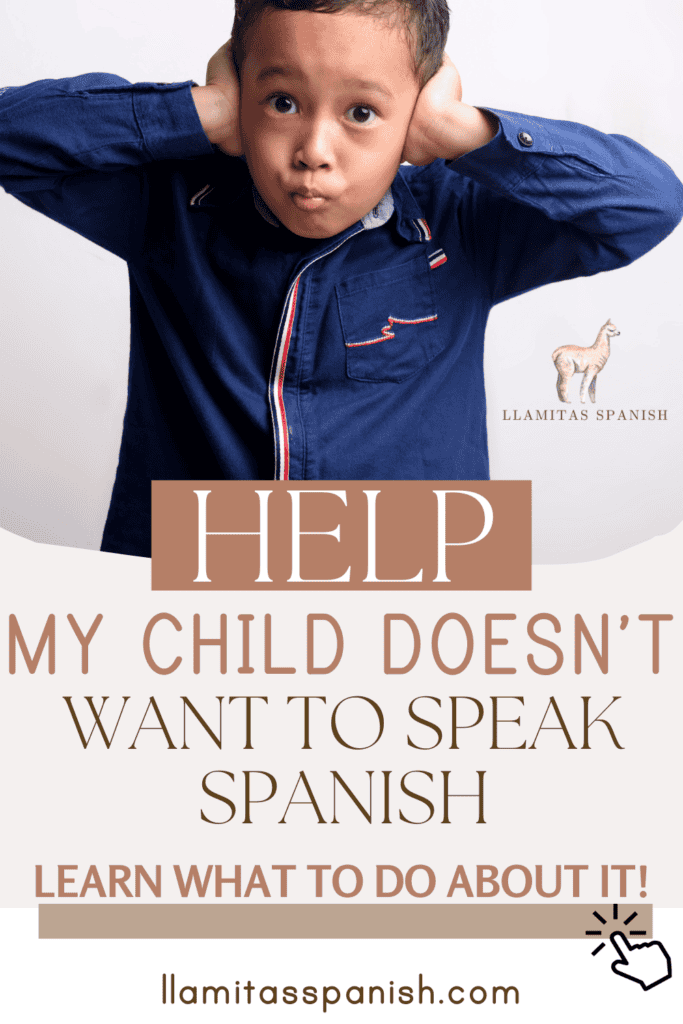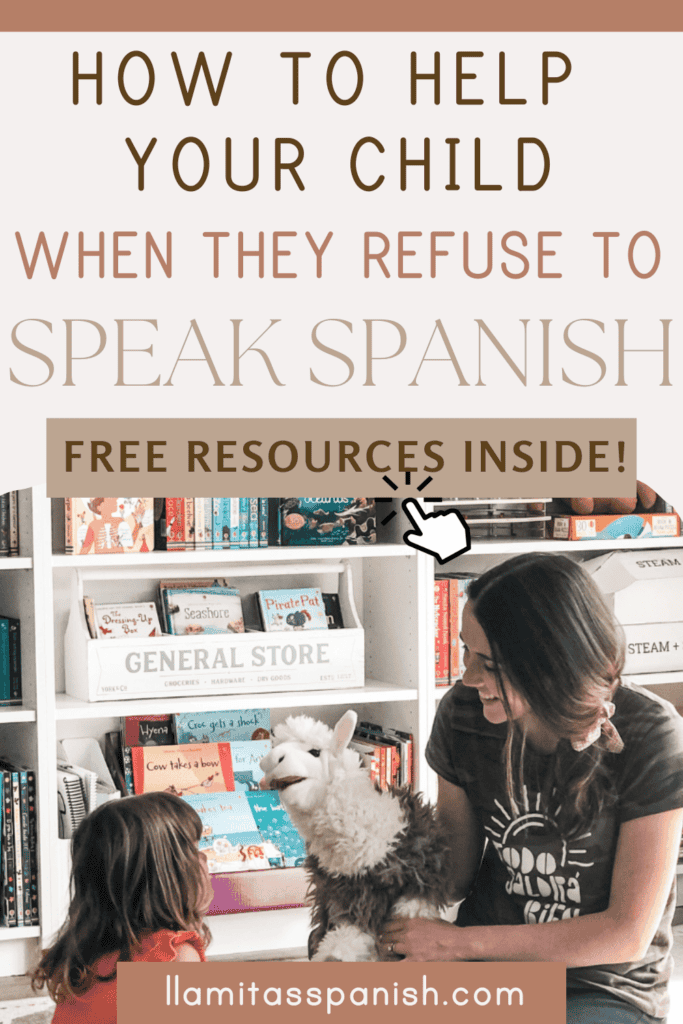In this post: Discover common reasons why your kid won’t speak Spanish at home… and what to do about it!
Is your child giving you push back, or completely refusing to speak the minority language at home? Or perhaps they just aren’t producing Spanish yet despite your best efforts.
It can be really disheartening when this happens, especially when we have invested so much time trying to raise them to be bilingual. But please know this is a very common situation.
We will look at some reasons why a child refuses to speak the target language, or isn’t producing it, as well as strategies you can take to overcome this (hopefully short) phase.

This post contains affiliate links.
When I started our family’s bilingual journey, over 4 years ago now, I had done a ton of prep.
I had gathered some resources, read up on best approaches and I had even created a ‘Spanish space’ in our playroom!
What could possibly go wrong?
I never once considered that my children might decide one day they just don’t want to speak Spanish.
Turns out, this resistance is very common and can happen at any age due to a variety of influences.
This reluctance, however, is not to be confused with ‘code mixing’ which also often happens with young bilingual children, and is actually a very cute phase that my youngest is still in.
So, I did a whole lot of research and turns out, this reluctance is very common and there are several triggers that can cause it.
Table of Contents
Five Common Reasons Why Your Child Isn’t Speaking Spanish and what to do about it!
You Haven’t Established a Need to Speak the Minority Language at Home
I was never a fan of math, but this formula I can handle:
Need + Exposure = Bilingual Ability
Reluctance to speak the minority language can generally be due to shortcomings in need and exposure.
Let’s take a look at need first: Without a doubt, the research suggests that creating a need increases motivation. Reduce the need and the motivation is drastically decreased. Makes sense, right?
Children are smart! If they know you understand them in the dominant language, why would they bother communicating in the minority language?
My children recently started attending a Dual Language Immersion public school. They have two teachers: a Native Spanish speaking teacher and a native English speaking teacher. They still have no idea that their Spanish teacher can actually speak fluent English. From the outset, they follow a OTOL method! (One Teacher One Language).
This can also be applied at home with a bilingual parenting policy. More on that in #3.
According to Beck in his book ‘Maximize your Child’s Bilingual Ability‘, the most important thing we can be for our children is a ‘bilingual model’. We need to set the stage and ‘condition’ them to communicate with us in the minority language.
Your Child is Embarrassed to Speak Spanish
This can happen for two reasons: they are not confident speaking Spanish because it’s their minority language. Or their friends do not speak Spanish and they don’t understand that bilingual is better.
In the first scenario, we need to keep encouraging and keep providing opportunities for immersion.
Speaking is almost always the part of language learning that people find most intimidating. Spanish online classes really really help to build confidence.
In the second situation, the child would likely benefit from more context. Living the language instead of trying to hide it.
This book from author Maritere Rodríguez Bellas is absolutely fantastic and hones in on this pain point. It is for preschool through elementary aged kids and will really help your child understand that bilingualism is a huge gift and something to be celebrated.
You Don’t Have a Bilingual Parenting Strategy
This is essentially choosing who speaks which language and when at home.
‘Your choice of language strategy- how your two (or more) languages will be used inside and outside the family- is a pivotal decision that could potentially make or break the success of your bilingual journey.’
Adam Beck
Make or break. Wow! Certainly not an area to ignore entirely or hope that it will ‘figure itself out’ then!
Most bilingual families decide early on how to organize their languages- who speaks what. There is no ‘right way’ as every family is unique. Annika Bourgogne presents the different approaches well in her book ‘Be Bilingual’:
There are plenty of approaches, but according to a study carried out by psycholinguist Annick de Houwer (study referenced in Beck’s ‘Maxmize your Child’s Bilingual Ability’ ) the highest odds (96%) of success are gained when both parents use the minority language at home.
This plummets to 35% when one parent uses both the minority and majority language and the other parent uses the majority.
I would argue UNLESS you outsource! Which is a huge part of my family’s Time & Place approach.
Time & Place is a very popular approach for non-native speaking families. It is essentially choosing specific times of the day and situations when you use the second language.
It is often very reliant on resources and outsourcing, and ultimately allows you to increase target language exposure for your child. (More on that in #5)
You are Not Making Spanish Fun
Ouch, hard truth here. As soon as your child starts to feel that speaking the target language is an obligation, the joy will be sucked right out of the journey. Joy is a powerful emotion and to ensure our kids view learning languages as ‘joyful’ we need to make the experience fun.
I have learnt over the years to be sensitive to my children’s engagement level, and I never force them to speak the target language.
Tap into their interests: is your child obsessed with trucks and trains right now? Gather several books and activities about that! It might not be what you had in mind, but that’s where they are engaged right now, so go with it!
I also built a learning environment rooted in engaging and beautiful resources. Reading aloud, playing lots and lots of games, listening to music, enjoying fun and interactive curricula are all excellent ways to make learning Spanish fun!

You Don’t Provide New Spanish Resources
Of course, you may not have any resources at all! Don’t panic. I was in that boat a few years ago.
Start small but be intentional. You can find lots of excellent free Spanish resources. Try to add a variety of materials like books, podcasts, apps, curricula and maybe even a fun subscription box.
A great place to start is also our Spanish Freebie Library >> (we are constantly adding new things!)
Having fresh materials in your home will help you immerse your child in the second language in a fun way and keep them engaged week after week.
Adam Beck describes the use of resources as a ‘large pitful’ of many families raising bilingual children’. If I think about my journey so far, it was so incredibly difficult to find quality resources.
That’s why I spent years creating the Spanish Resource Hub, providing families with a one-stop-shop for all their Spanish resource needs.
The Ultimate Guide to Learning Spanish at Home
If you need a complete step-by-step guide to creating a solid bilingual parenting plan, and finding the best Spanish resources on the market, this is for you!
This Learn Spanish en Casa eBook and Workbook bundle takes you through 10 core chapters for establishing a strategy and executing it to successfully raise bilingual children!
Well I sure hope these tips encourage you to stick at it! If your child is refusing to speak the target language, just breathe and reset.
The journey to bilingualism is not always easy, nor straight forward, but it is SO worth it.
Related Posts:
How to Teach your Kids Spanish
Founder of the Llamitas Spanish® Curriculum and former Spanish teacher. Corrie holds two Master Degrees in Spanish and Education. She lives in San Diego, California with her husband and two bilingual children.



